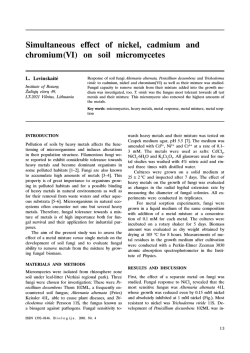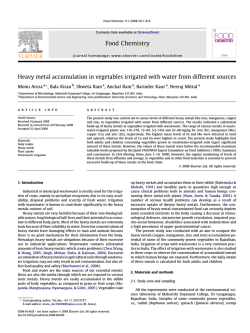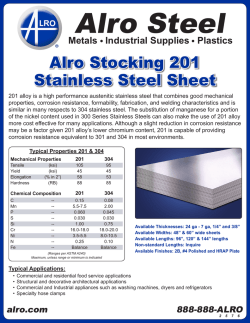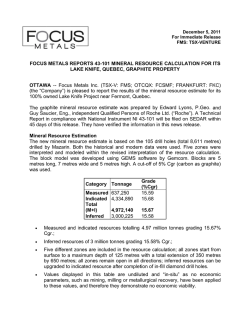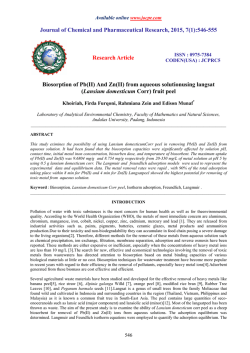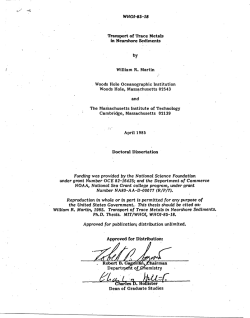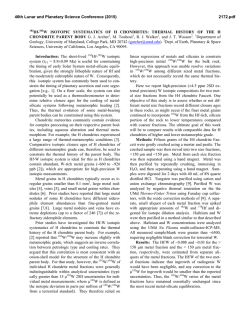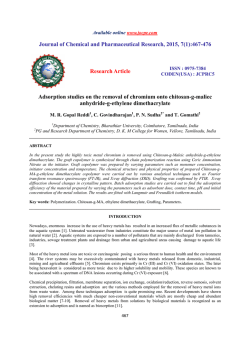
Removal efficacy of biosorbents and low cost adsorbents for toxic
Available online www.jocpr.com Journal of Chemical and Pharmaceutical Research, 2015, 7(1):209-213 Research Article ISSN : 0975-7384 CODEN(USA) : JCPRC5 Removal efficacy of biosorbents and low cost adsorbents for toxic metal ions: Chemical free purification of water Firoze Ahmad Dept. of Zoology, G. B. College, Naugachia, TMBU, Bhagalpur(Bihar), India _____________________________________________________________________________________________ ABSTRACT Toxic metals like mercury, chromium, cadmium, cobalt and nickel must be completely absent in drinking water because in spite of their miniature existence, they seem to be have high potential for causing terrible health effects e.g., mercury affects nervous system, chromium causes gastric erosion, cadmium is carcinogenic and mainly affects kidney. Arsenic is potent carcinogenic and mainly affects gastro-intestine and skin. In the present study, number of treatment methods had been adopted for the safe removal of heavy metal ions from aqueous solutions and water samples from industrial effluents. These had shown that the aquatic plants are efficient water filters and effective in removing metals from polluted water. The adsorption of toxic metals took place by low cost adsorbents such as activated carbon, walnut shell, waste tea, sawdust, zeolite, Bentonite, china clay and Peat moss. Chemical free removal of toxic metal ions from dilute aqueous solutions by biosorbents and low cost adsorbents has been demonstrated to be a useful alternative to conventional treatment systems. Adsorption is a physical process where soluble molecules (adsorbates) are removed by attachment to the surface of a solid substrate (adsorbent) primarily by Van der Waals forces, although chemical or electrical attraction may also be important. Adsorbents must have a very high specific surface area. Keywords: Toxic metals, Heavy metals, Adsorption, Bio-sorption _____________________________________________________________________________________________ INTRODUCTION Water filtration is a natural and integral part of life, and it is a process aided by a variety of animals and natural materials. The earth has many natural methods of water filtration, and humankind has also used materials to purify water for thousands of years. Some are specific to remove toxic metals within shortest period of time. Heavy metals (toxic metals) are elements that have relatively high density, and they are toxic or poisonous even at low concentrations (Lenntech, 2004). Thus toxic metals like mercury, chromium, cadmium, cobalt and nickel must be completely absent in drinking water because in spite of their miniature existence, they seem to have high potential for causing terrible health effects e.g., mercury affects nervous system, chromium causes gastric erosion(Cr VI is more toxic than Cr III) , cadmium is carcinogenic and mainly affects kidney. Arsenic is also a potent carcinogenic metal and mainly affects gastrointestinal tract and skin. Toxic metal ions can enter a water supply by industrial effluents and consumer waste. Nature has own water purifiers such as sands, clay, charcoal, minerals (bentonites) , ceramics, plants and their material. Some are specific to remove the toxic metals within the shortest period of time. During study it was found that water hyacinth i.e., Jal Kumbhi and Kakoli absorbed toxic metals - chromium, lead, mercury, cobalt within 40 minutes from industrial effluents. Peat moss absorbed mercury, lead, cadmium, chromium within 30 minutes from the industrial effluents. 209 Firoze Ahmad J. Chem. Pharm. Res., 2015, 7(1):209-213 ______________________________________________________________________________ China clay had been found very effective for removal of cadmium from aqueous solutions. It is the cheapest way for the removal of toxic metal ions. EXPERIMENTAL SECTION 1.1 Location and Climate: Bhagalpur district comprising of eight regions viz. Nathnagar, Kilaghat, Sarai, Naya Bazar, Barari, Sabour, Naugachia and Madrouni lies between 250 13.29 and 250608’ north of equator and between the longitudinal lines of 880 and 97030’E. Uttar Pradesh, West Bengal, Jharkhand and Nepal bound this region on its sides. The land surface of Bihar is generally plain with Gangetic areas. This region covers an area of approximately 150 km2 which includes Gangetic plain, the most populous part and constitutes about 22% of the region. The region is situated in the Sultanganj to Kahalgaon and Naugachia to Madrouni in Koshi region and is considered the richest biogeographical zone. The climate of this region is influenced and characterized by its hot humid to temperate. This region receives high precipitation during monsoon period which creates flood. Due to heavy rain fall, ground water reserves are generally adequate in some of the areas, (Naugachia, Bihpur) while scarcity of water is observed in most of the areas of the town. The average decline of groundwater level of Bhagalpur Town is nearly 5ft.per year as per self-estimated record of the author. The temperature varies between 28oC to 35oC. 1.2 Water sample collection from industrial effluents: The samples were collected from industrial effluents in the year 2011 and 2012 from Bhagalpur and its adjoining areas. Samples were collected in plastic containers (PVC 250 ml). Preservative (1:1 HNO3 solution to PH<2, about 3 ml L-1 sample) were added to each water samples at the time of sampling and containers were sealed. These samples were tested for heavy metals and other physico-chemical parameters and treated with a number of Biosorbents and low cost absorbents for their potential to remove toxic metals (chemical free purification of water). 1.3 Method of analysis: The physical parameters like pH, DO, TDS, and turbidity were tested in the field at the time of sample collection using portable pH meter (Eutech Instrument) and water testing kit (MS Electronics, India). Analysis of cadmium, copper, iron, lead, nickel, zinc and chromium was done using Atomic Absorption Spectrophotometer (Perkin Elmer AA200). Arsenic metals were analyzed using Spectrophotometer with MH-15(Mercury Hydride System) at 193.7 analytical wavelengths and 0.7 nm slit width. 1.4 Preparation of Adsorbate Solutions Metal Solutions: An aqueous stock solution (1000mg/l) was prepared for each heavy metal i.e., for chromium by dissolving 3.734 of potassium dichromate in 1 liter of distilled water. 5ml. of HNO3 was added to it, for Zn, 6.5mg/l Zn2+and 1000mg/l sorbent (LS) of initial Ph5 and for P(II) by dissolving lead nitrate in bi-distilled water at 1000 mg/l. Working solutions were prepared by diluting different volume stock solution to achieve the desired concentration. The amount of metal adsorbed by the solid (q) and the percent of metal removal were calculated using the following equations: q = (Co-Ce) V/m Metal ions removal (%) = (Co-Ce) 100/Co Where Co is initial concentration metal ions (mg/l)’ Ce is the concentration of metal ions at equilibrium adsorption (mg/l), V is the volume of solution ( l ) and m is the mass of adsorbent (g) 1.5 Acceptable limit of Metals mg/l: Ar-0.05, Cd-0.01,Cr-0.05,Pb-0.1,Hg-0.001,Zn-5.0 210 Firoze Ahmad J. Chem. Pharm. Res., 2015, 7(1):209-213 ______________________________________________________________________________ RESULTS AND DISCUSSION The results showed that the removal of toxic metal ions by bio-sorbents and low cost adsorbents from aqueous solutions and industrial effluents was slow but effective. These methods were proved to be useful alternative to conventional treatment system. 2.1 Plants: Bio-sorbents for metal removal Plants are natural choice for filtration of water, especially in wetland areas. Some plants also remove heavy metals and toxins while stimulating the growth of beneficial bacteria. Water lettuce and water hyacinth were so effective that they were sometimes incorporated into the first step of waste water purification (V.P. Kudesia 2002-03) [5] Present study depicts that water hyacinth (Jalkumbhi, Kakoli) was proved as boon to lower B.O.D., TDS, organics, nitrogen, phosphorous and metals from industrial effluents.Table-1 shows that short roots of hyacinth are efficient water filters and removes Cr(VI), Pb(II), Co. Sharp decline of TDS is due to heavy extraction of minerals by plant. Table-1 Removal of Pollutants by Water Hyacinth (All Values were in mg/l) Flow Inflow Outflow BOD 5.11 4.2 PARMAETERS TDS ORGANICS 1678 96 246 22 METALS 0.93 0.01 PHOSPHORUS 0.76 0.11 NITROGEN 3.15 0.57 2.2 Low cost adsorbents for heavy metal removal: Use of low cost adsorbents for chemical free water purification is cost effective and eco- friendly. Studies have shown that activated carbon removes Pb(II) (Teles de Vasconcelos and Gonzalez Beca, 1994),[12] Walnut shell removes Cd and chromium (VI) (Orhan and Buyukgungor, 1993) [8] waste tea removes Cd and Cr (VI) (Orhan and Buyunkgungor, 1993),[8] Zeolite removes Cd, Br (III), Hg, Pb(II) (Leppert, 1990),[7] Activated carbon removes Arsenic (A.K. Jha and Firoze Ahmad, 2014),-[work is in progress], Bentonite removes Cr (VI), Pb(II) and Zn (Khan et al 1995,[6] Cadena et al, 1990,[3] Kayaa and Oren, 2005),[4] Bentonites of Rajmahal hill removes arsenic and fluoride from water (A. K. Jha and B.Mishra, 2012),[2] China clay removes Pb(II) (Yadava et al, 1991),[13] Flyash removes Cr (VI), Pb(II), Zn (Pandey et al, 2005),[9] A combination of both Fly ash and china-clay removes Cr (VI) more than that of Fly-ash alone (Pandey et al, 1984) ,[a9] Peat moss - Irish sphagnum moss peat removes Cr (VI) Sharma and Forster,1993,1995,[11-12] Some of the low cost adsorbents taken into accounts include Bark/tannin-rich materials; lignin; chitin/chitosan, zeolite; clay; fly-ash; tea waste; walnut shell activated carbon and peat moss and the investigated reports were as followed. Table -2. Investigated adsorption capacities (mg/g) for tanning containing materials Materials Activated carbon Walnut shell Waste tea Source Aqueous solution Aqueous solution Aqueous solution Cd Cr(VI) 1.3 1.21 1.49 1.44 Pb (II) 2.90 The polyhydroxy polyphenol groups of tannin are thought the active species in adsorption process. Ion exchange takes place as metal cations displaces adjacent phenolic hydroxyl groups, forming a chelate. Table-2 showed that tanning containing materials removed Cd, Cr (VI) and Pb (II) from aqueous solution. Case II Zeolite : Zeolites are a naturally occurring crystalline Alumino-silicates consisting of a framework of tetrahedral molecules, linked with each other by shared oxygen atoms. Natural Zeolites gained a significant interest, due to their ionexchange capability to preferentially remove unwanted heavy metals. Table showed it removed Cd ,Cr(III)and Pb 211 Firoze Ahmad J. Chem. Pharm. Res., 2015, 7(1):209-213 ______________________________________________________________________________ Table-3. Investigated adsorption capacities (mg/g) for Zeolite Material Zeolite Source Aqueous solution Cd 83.9 Cr(III) 25.7 Pb(II) 148.3 Case III Clay : Clay : smactites (such as montmorillonite), Kaoline and micas; out of which montmorillonite has the highest cation exchange capacity such as Zn2+, Pb2+, Al3+ from aqueous solutions. It is 20 times cheaper than that of activated carbon. Although the removal efficacy of clays for heavy metals may not be as good as that of Zeolites, their easy availability and low cost may compensate its drawbacks. Table - 4. Investigated Adsorption capacities (mg/gm) for clays Materials Bentonite China clay Fly ash . China clay Source Aqueous solution Aqueous solution Aqueous solution Aqueous solution Cr(VI) 0.49 Pb(II) 5.6 Zn 0.91 0.288 4.9 9.9 3.1 0.30 Table-4 showed that clay removed Cr (VI), Pb (II) and Zinc from aqueous solution Case IV Peat Moss: Peat moss is a complex soil material containing lignin and cellulose. Peat moss has a large surface area (7200 m2/g) and is highly porous so that it can be used to bind heavy metals. Peat moss is a good absorbent for all metals. It is widely known that peat moss exhibited a high CEC and complexities towards metals due to the presence of carboxylic, phenolic and hydroxylic functional groups. Following were the result of adsorption capacities for Peat Moss after investigation (Table-5). Table -5 Investigated Adsorption capacities (mg/g) for Peat Moss Materials Irish sphagnum moss peat Source Aqueous solution Cd ……….. Cr(VI) 119.1, 43.8 Pb (II) ………. CONCLUSION Bio-sorption or low cost adsorption has advantages compared with conventional techniques: 1. Cheap: The cost of the bio-sorbent or adsorbent is low since they often are made from abundant or waste material. 2. Metal selective: The metalsorbing performance of different types of biomass can be more or less selective on different metals. This depends on various factors such as type of biomass, mixture in the solution, type of biomass preparation and physico-chemical treatment. 3. Regenerative: Bio-sorbents can be reused, after the metal is recycled.\ 4. No sludge generation: No secondary problems with sludge occur with bio-sorption, as is the case with many other techniques, for example, precipitation. 5. Metal recovery possible: In case of metals, it can be recovered after being sorbed from the solution. 6. Competitive performance: Bio-sorption is capable of a performance comparable to the most similar technique, ion exchange treatment. Ion exchange is, as mentioned above, rather costly, making the low cost of bio-sorption or adsorption, major factor. Thus studies showed that natural materials are cost effective efficient water filters and can be used for heavy metal ions removal. The methods are eco-friendly and should be taken into accounts on large scale. Acknowledgement 212 Firoze Ahmad J. Chem. Pharm. Res., 2015, 7(1):209-213 ______________________________________________________________________________ The author is grateful to Prof. S.P. Roy, Dean, faculty of Science, T. M .Bhagalpur University, Bhagalpur for valuable suggestions and encouragement. REFERENCES [1] APHA : Standard method of examination of water and waste water , 19th Edition, American Health Association, Washington D.C. (1995) [2] A. K. Jha and B. Mishra, J. Indian Chemical Soc. 2012,89,519-21 [3] Cadena F. Rizvi. And Peters R.W., Feasibility studies for the removal of heavy metals from solution using tailored bentonite. In hazardous and Industrial wastes, Proceedings of the Twenty second Mid-Atlantic Industrial waste conference, Derevel University, 1990, 77-94 [4] Kayaa Abidin and Orenb Ali Hakan , Journal of Hazardous Materials,2005, 125(1-3),183-189. [5] V.P. Kudesia, Water pollution.5th Revised Edition, Pragati Prakashan,Merut, 2002-03 , 675 [6] Khan S.A; Rainzur-Rahman A and Khan M.A., Waste Manage.1995, 15(4),271-282 [7] Leppert D, Mining Eng.1990 42(4) pp.604-608 [8] Orhan Y., Water Sci. Technol.1993, 28(2) 247-255 [9] Pandey K.K.; Prasad G. and Singh V.N., J. Chem. Tech. Biotechnol.1984 , A34,367-374 [10] Sharma D.C. and Foster C.F. , Water Res. 1993, 22(7), 1201-1208 [11] Sharma D.C. and Foster C. F., Process Biochem 1995.30(4), 293-298 [12] Teles de Vasconcelos L.and. Gonzaalez Beca C.G., Eur. Water poll. Control 4 (1), 41-51 [13] Yadava K.P; Tyagi B.S. and Singh V.N., J. Chem. Biotechnol. 1991 51, 47-60 213
© Copyright 2026
